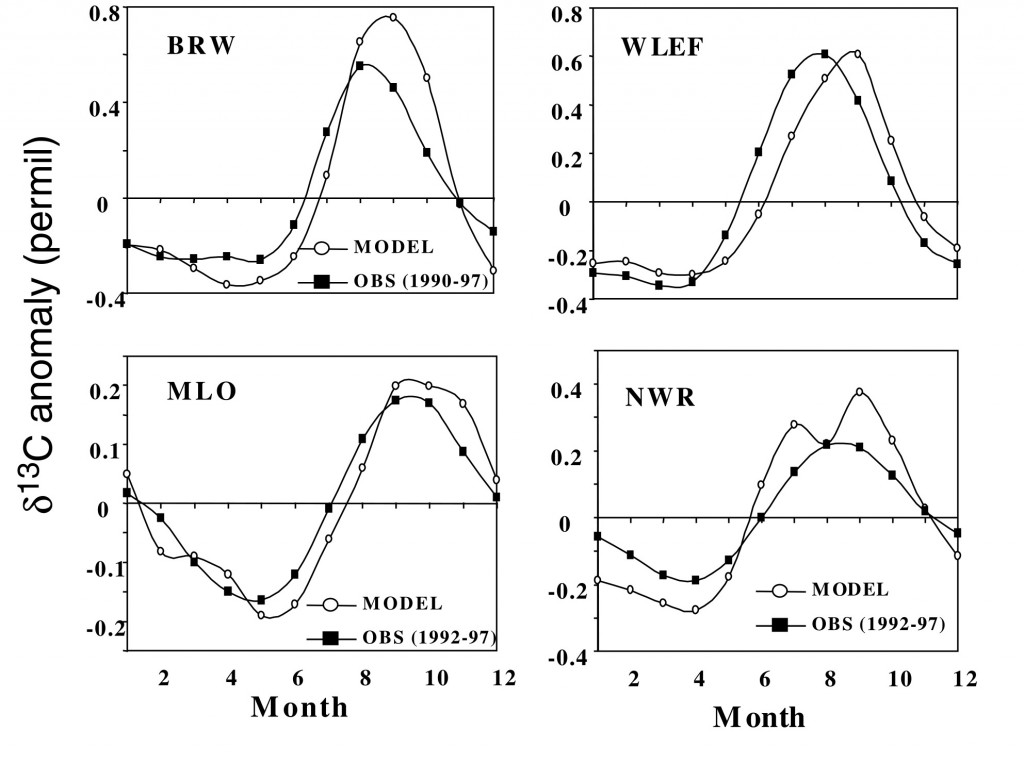NSF Isotopes CCSM
NSF 2003 – 2005
We propose a three-year research program to study the exchanges of CO2 and 13CO2 between the atmosphere, ocean, and terrestrial biosphere, and the processes that govern them. Spatial and temporal variations of these two tracers in the atmosphere contain information about the sources and sinks of CO2. The stable isotope ratio δ13C can be used to partition a total flux into terrestrial and marine components, reducing uncertainties in regional monthly fluxes calculated by inversion of tracer transport models. The ratio of 12C to 13C fluxes on land depends on physiological stress (which controls isotopic discrimination via stomatal conductance and Ci/Ca ratios) and the pathways and turnover times of photosynthate in ecosystems (which impacts isotopic disequilibrium). We have developed logic describing these processes on land in the Simple Biosphere model (SiB2), which has been successful at predicting variations in CO2 and δ13C on local, regional, and global scales when coupled to an atmospheric model.
The stable isotope code we have already developed and tested will be ported into the Community Climate System Model (CCSM), which is maintained at the National Center for Atmospheric Research (NCAR). The advantages of doing this are: (1) the Community Land Model (CLM) in the CCSM already calculates photosynthesis and respiration using logic very similar to that in SiB2; (2) new functionality is being developed in CLM/CCSM that includes dynamic vegetation (ecosystem succession and disturbance) and biogeochemical cycling of carbon and nitrogen through ecosystem pools, which is important for the calculation of isotopic disequilibrium; (3) a parameterization of the carbon cycle and δ13C in the ocean has already been developed in the NCAR CCSM Ocean Model (NCOM), allowing prediction of spatial, seasonal, and interannual variations in fractionation and disequilibrium at the air-sea interface; (4) the fully coupled model of the carbon cycle and δ13C that will be completed when we have ported our code into this model is an ideal testbed for evaluation of the component models against atmospheric and ecosystem data; and (5) the global self-consistent process-based model we build will allow us to develop synthetic atmospheric data sets for testing new approaches to CO2 inversion using multiple tracers and to recommend future observing priorities.
Inversion of observed patterns in atmospheric CO2 concentrations to estimate surface fluxes is ill-conditioned because response patterns in the current network are not unique, especially with respect to terrestrial fluxes estimated from stations in the marine boundary layer. We propose to develop new inversion methods that make better use of the δ13C constraints, including variations in both discrimination and isotopic disequilibrium between the atmosphere and terrestrial ecosystems. These variations can be modeled in the coupled process-based model described above, and their uncertainty estimated to help constrain flux inversions. In addition, we will attempt to use these variations to extract information from the observations about the effects of environmental forcing on physiological stress and pathways and turnover of organic matter. These new inversion methods will be developed and tested using synthetic data produced by the CCSM, and the sensitivity to transport will be investigated using a suite of transport model response functions produced in a model intercomparison study (TransCom). Finally, we will perform an inversion of the past 20 years of atmospheric CO2 and δ13C data to estimate regional monthly fluxes, isotopic exchanges, and the processes that control them


